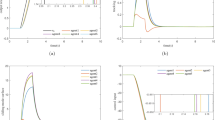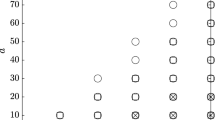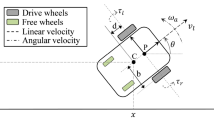Abstract
A new intelligent anti-swing control scheme, which combined fuzzy neural network (FNN) and sliding mode control (SMC) with particle swarm optimization (PSO), was presented for bridge crane. The outputs of three fuzzy neural networks were used to approach the uncertainties of the positioning subsystem, lifting-rope subsystem and anti-swing subsystem. Then, the parameters of the controller were optimized with PSO to enable the system to have good dynamic performances. During the process of high-speed load hoisting and dropping, this method can not only realize the accurate position of the trolley and eliminate the sway of the load in spite of existing uncertainties, and the maximum swing angle is only ±0.1 rad, but also completely eliminate the chattering of conventional sliding mode control and improve the robustness of system. The simulation results show the correctness and validity of this method.
Similar content being viewed by others
References
CHO S K, LEE H H. A fuzzy-logic antiswing controller for three- dimensional overhead cranes [J]. ISA Transactions, 2002, 41(2): 235–243.
JORG N, ECKHARD A, KLAUS S, OLIVER S. Tracking and anti-sway control for boom cranes [J]. Control Engineering Practice, 2010, 18(1): 31–44.
CHANG Cheng-yuan, CHIANG Kuo-hung. Fuzzy projection control law and its application to the overhead crane [J]. Mechatronics, 2008, 18(10): 607–615.
MIZUMOTO I, CHEN Tong-wen, OHDAIRA S. Adaptive output feedback control of general MIMO systems using multirate sampling and its application to a cart-crane system [J]. Automatica, 2007, 43(12): 2077–2085.
SORENSEN K L, SINGHOSE W, DICKERSON S. A controller enabling precise positioning and sway reduction in bridge and gantry cranes [J]. Control Engineering Practice, 2007, 15(7): 825–837.
YANG Jung-hua, YANG Kuang Shine. Adaptive coupling control for overhead crane systems [J]. Mechatronics, 2007, 17(2/3): 143–152.
ZIYAD N M, MOHAMMED F D. A graphical design of an input-shaping controller for quay-side container cranes with large hoisting:theory and experiments [J]. Jordan Journal of Mechanical and Industrial Engineering, 2007, 1(1): 57–67.
SINGHOSE W, KAMOI T, TAURA A. Radial-motion assisted command shapers for nonlinear tower crane rotational slewing [J]. Control Engineering Practice, 2010, 18(5): 523–531.
NAOKI U. Robust control of rotary crane by partial-state feedback with integrator [J]. Mechatronics, 2009, 19(8): 1294–1302.
MAHMUD I S, WAHYUDI. Sensorless anti-swing control for automatic gantry crane system: Model-based approach [J]. International Journal of Applied Engineering Research, 2007, 2(1): 147–161.
YU W, ARMENDARIZ M A, RODRIGUEZ F O. Stable adaptive compensation with fuzzy CMAC for an overhead crane [J]. Information Sciences, 2011, 181(21): 4895–4907.
ZHANG Xi-zheng, WANG Yao-nan. Robust fuzzy sliding-mode control for T-S model based permanent magnet synchronous motor [J]. Journal of Central South University: Science and Technology, 2009, 40(S1): 68–73.
ZHANG Zhi-gang, ZHANG Gui-xiang. Combined control of sliding mode variable structure vector for permanent magnet synchronous wind power system [J]. Journal of Central South University: Science and Technology, 2011, 42(7): 1986–1991. (in Chinese)
LIU Dian-tong, YI Jian-qiang, ZHAO Dong-bin, WANG Wei. Swing-Free transporting of two-dimensional overhead crane using sliding mode fuzzy control [C]// Proceeding of the 2004 American Control Conference. Boston: Institute of Electrical and Electronics and Engineers Inc, 2004: 1764–1769.
IEROHAM S B, LUIS-ALBERTO H P, CARLOS-ROMAN M G. An adaptive sliding mode control with I-term using recurrent neural identifier [J]. Bulgarian Academy of Sciences Cybernetics and Information Technologies, 2007, 7(1): 21–32.
KENNEDY J, EBERHART R C. Particle swarm optimization [C]// Proceedings of the 1995 IEEE International Conference on Neural Networks. Perth: IEEE Press, 1995: 1942–1948.
CHATTERJEE A, CHATTERJEE R, MATSUNO F, ENDO T. Neuro-fuzzy state modeling of flexible robotic arm employing dynamically varying cognitive and social component based PSO [J]. Measurement, 2007, 40(6): 628–643.
Author information
Authors and Affiliations
Corresponding author
Additional information
Foundation item: Project(51075289) supported by the National Natural Science Foundation of China; Project(20122014) supported by the Doctor Foundation of Taiyuan University of Science and Technology, China
Rights and permissions
About this article
Cite this article
Chen, Zm., Meng, Wj. & Zhang, Jg. Intelligent anti-swing control for bridge crane. J. Cent. South Univ. 19, 2774–2781 (2012). https://doi.org/10.1007/s11771-012-1341-6
Received:
Accepted:
Published:
Issue Date:
DOI: https://doi.org/10.1007/s11771-012-1341-6




